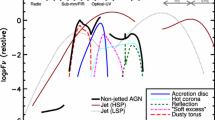Abstract
This study’s objective was to exploit infrared VVV (VISTA Variables in the Via Lactea) photometry for high latitude RRab stars to establish an accurate Galactic Centre distance. RRab candidates were discovered and reaffirmed (\(n=4194\)) by matching \(K_{s}\) photometry with templates via \(\chi ^{2}\) minimization, and contaminants were reduced by ensuring targets adhered to a strict period-amplitude (\(\Delta K_{s}\)) trend and passed the Elorietta et al. classifier. The distance to the Galactic Centre was determined from a high latitude Bulge subsample (\(|b|>4^{\circ}\), \(R_{\mathit{GC}}=8.30 \pm 0.36\) kpc, random uncertainty is relatively negligible), and importantly, the comparatively low color-excess and uncrowded location mitigated uncertainties tied to the extinction law, the magnitude-limited nature of the analysis, and photometric contamination. Circumventing those problems resulted in a key uncertainty being the \(M_{K_{s}}\) relation, which was derived using LMC RRab stars (\(M_{K_{s}}=-(2.66\pm 0.06) \log {P}-(1.03\pm 0.06)\), \((J-K_{s})_{0}=(0.31\pm 0.04) \log {P} + (0.35\pm 0.02)\), assuming \(\mu _{0,\mathit{LMC}}=18.43\)). The Galactic Centre distance was not corrected for the cone-effect. Lastly, a new distance indicator emerged as brighter overdensities in the period-magnitude-amplitude diagrams analyzed, which arise from blended RRab and red clump stars. Blending may thrust faint extragalactic variables into the range of detectability.





Similar content being viewed by others
References
Alonso-García, J., Minniti, D., Catelan, M., et al.: Astrophys. J. Lett. 849, L13 (2017)
Alves, D.R., Rejkuba, M., Minniti, D., Cook, K.H.: Astrophys. J. Lett. 573, L51 (2002)
Berdnikov, L.N., Dambis, A.K., Vozyakova, O.V.: Astron. Astrophys. Suppl. Ser. 143, 211 (2000)
Bhardwaj, A., Rejkuba, M., Minniti, D., et al.: Astron. Astrophys. 605, A100 (2017)
Bland-Hawthorn, J., Gerhard, O.: Annu. Rev. Astron. Astrophys. 54, 529 (2016)
Carraro, G., Turner, D., Majaess, D., Baume, G.: Astron. Astrophys. 555, A50 (2013)
Cioni, M.-R.L., Clementini, G., Girardi, L., et al.: Astron. Astrophys. 527, A116 (2011)
Collinge, M.J., Sumi, T., Fabrycky, D.: Astrophys. J. 651, 197 (2006)
Cross, N.J.G., Collins, R.S., Mann, R.G., et al.: Astron. Astrophys. 548, A119 (2012)
de Grijs, R., Bono, G.: Astrophys. J. Suppl. Ser. 227, 5 (2016)
Dékány, I., Minniti, D., Catelan, M., et al.: Astrophys. J. Lett. 776, L19 (2013)
Dékány, I., Minniti, D., Majaess, D., et al.: Astrophys. J. Lett. 812, L29 (2015)
Dékány, I., Hajdu, G., Grebel, E.K., et al.: Astrophys. J. 857, 54 (2018)
Elorrieta, F., Eyheramendy, S., Jordán, A., et al.: Astron. Astrophys. 595, A82 (2016)
Gieren, W., Pilecki, B., Pietrzyński, G., et al.: Astrophys. J. 815, 28 (2015)
González-Fernández, C., Hodgkin, S.T., Irwin, M.J., et al.: (2017). arXiv:1711.08805
Gran, F., Minniti, D., Saito, R.K., et al.: Astron. Astrophys. 591, A145 (2016)
Majaess, D.: Acta Astron. 60, 121 (2010)
Majaess, D., Turner, D., Gieren, W.: Astrophys. J. Lett. 741, L36 (2011a)
Majaess, D.J., Turner, D.G., Lane, D.J., Henden, A.A., Krajci, T.: J. Am. Assoc. Var. Star Obs. 39, 122 (2011b)
Majaess, D., Turner, D., Gieren, W., Lane, D.: Astrophys. J. Lett. 752, L10 (2012)
Majaess, D., Turner, D., Dékány, I., Minniti, D., Gieren, W.: Astron. Astrophys. 593, A124 (2016)
Mateu, C., Read, J.I., Kawata, D.: (2017). arXiv:1711.03967
Minniti, D., Lucas, P.W., Emerson, J.P., et al.: New Astron. 15, 433 (2010)
Minniti, D., Dékány, I., Majaess, D., et al.: Astron. J. 153, 179 (2017a)
Minniti, D., Palma, T., Dékány, I., et al.: Astrophys. J. Lett. 838, L14 (2017b)
Minniti, D., Saito, R.K., Gonzalez, O.A., et al.: (2018). arXiv:1804.07785
Monson, A.J., Pierce, M.J.: Astrophys. J. Suppl. Ser. 193, 12 (2011)
Muraveva, T., Palmer, M., Clementini, G., et al.: Astrophys. J. 807, 127 (2015)
Pietrukowicz, P., Kozłowski, S., Skowron, J., et al.: Astrophys. J. 811, 113 (2015)
Pietrzyński, G., Graczyk, D., Gieren, W., et al.: Nature 495, 76 (2013)
Saito, R.K., Hempel, M., Minniti, D., et al.: Astron. Astrophys. 537, A107 (2012)
Smith, M.C., Woźniak, P., Mao, S., Sumi, T.: Mon. Not. R. Astron. Soc. 380, 805 (2007)
Soszyński, I., Udalski, A., Szymański, M.K., et al.: Acta Astron. 59, 1 (2009)
Soszyński, I., Udalski, A., Szymański, M.K., et al.: Acta Astron. 64, 177 (2014)
Turner, D.G.: Can. J. Phys. 92, 959 (2014)
Udalski, A.: Astrophys. J. 590, 284 (2003)
Zechmeister, M., Kürster, M.: Astron. Astrophys. 496, 577 (2009)
Acknowledgements
D.M. (Majaess) is grateful to the following individuals and consortia whose efforts, advice, or encouragement enabled the research: OGLE, VSA (N. Cross & M. Read), CDS, 2MASS, arXiv, and NASA ADS. I.D. was supported by Sonderforschungsbereich SFB 881 “The Milky Way System” (subproject A3) of the German Research Foundation (DFG). Data analysis was partly carried out on the Milky Way supercomputer, which is funded by the Deutsche Forschungsgemeinschaft (DFG) through the Collaborative Research Center (SFB 881) “The Milky Way System” (subproject Z2). G.H. acknowledges support from the Graduate Student Exchange Fellowship Program between the Institute of Astrophysics of the Pontificia Universidad Católica de Chile and the Zentrum für Astronomie der Universität Heidelberg, funded by the Heidelberg Center in Santiago de Chile and the Deutscher Akademischer Austauschdienst (DAAD), by the CONICYT-PCHA/Doctorado Nacional grant 2014-63140099, by FONDECYT grant #1171273, and by CONICYT’s PCI program through grant DPI20140066. G.H., D.M. (Minniti), and W.G. gratefully acknowledge support from the Millenium Institute of Astrophysics (MAS) of the Iniciativa Cientifica Milenio del Ministerio de Economia, Fomento y Turismo de Chile, grant IC120009, and the BASAL Centro de Astrofisica y Tecnologias Afines (CATA) PFB-06/2007. D.M. (Minniti) likewise acknowledges support from FONDECYT Regular grant No. 1170121. W.G. likewise acknowledges support from the European Research Council (ERC) under the European Unions Horizon 2020 research and innovation program (grant agreement No. 695099).
Author information
Authors and Affiliations
Corresponding author
Rights and permissions
About this article
Cite this article
Majaess, D., Dékány, I., Hajdu, G. et al. Establishing the Galactic Centre distance using VVV Bulge RR Lyrae variables. Astrophys Space Sci 363, 127 (2018). https://doi.org/10.1007/s10509-018-3346-6
Received:
Accepted:
Published:
DOI: https://doi.org/10.1007/s10509-018-3346-6




